Written by James Parsons - https://medium.com/@jampars88_56611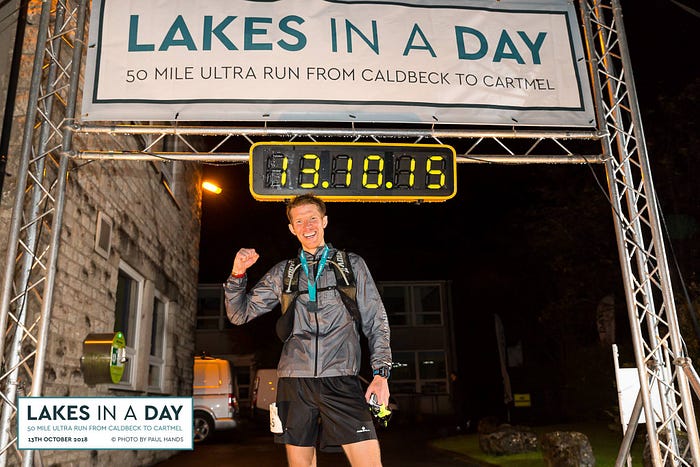
Distance: 81.9km (50.9 miles)
Elevation: 4,001 metres
Participants: 485 sign-ups, 378 starters, 240 finishers
Wind: up to 70mph (on summits)
Rain: shitloads
Official result: 13:03:05 (19th overall, 18th male).
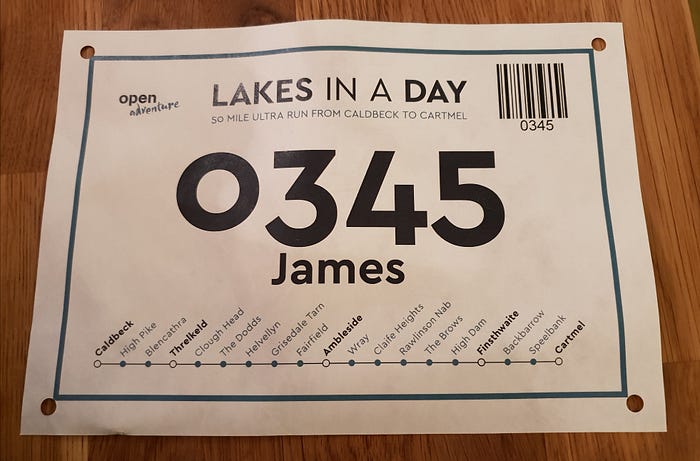
Race prep
You know the score by now — Lakes in a Day (LiaD) is a 50 mile ultra-marathon between two picturesque Lakeland villages (Caldbeck and Cartmel), with a few climbs in between. It’s what I’d been building towards all season.
I signed up to LiaD as soon as entries opened in late-2017, instantly attracted to the idea of a point-to-point adventure race from the top of the Lakes to the bottom. At the time I had zero experience of traversing the mountains of England — and couldn’t navigate my way out of the back garden. Thankfully I convinced Chris to sign up, too, so we’d enjoy the next 12 months prep together.
The early mornings, stupid distances and multiple trips to the Lakes — they were all aimed at conditioning the body to go that little bit further, falling apart a little less each time. I took part in my first proper fell race in early August 2018. Borrowdale was, to put it mildly, an ordeal. I had started off at the back, giving the occasion the respect it deserved. Worked my way through the field, thinking this ain’t so bad, powering up a couple of fells and hurtling down the scree off Scafell Pike. Then came Great Gable. The climb was okay, but people started coming past. Not a problem, I thought — I’ll get them on the way down. When I passed the summit and started the descent, however, something wasn’t right. My hips had aged at least 50 years. As I shuffled down Great Gable with seasoned fell runners bounding past, I learnt a painful lesson — my legs just weren’t up to the rigours of long-distance fell running. Oh, and note to self: don’t start LiaD like a lunatic come October.
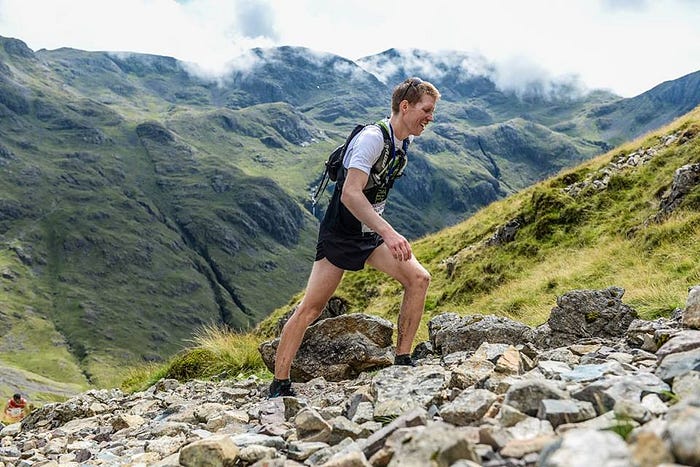
By the end of the holiday I’d recced the entire 50 miles (and then some). Great, I thought — I know where I’m going and when the big efforts are needed. But how on earth am I going to stitch it all together come October? Fast forward two months and I was still asking myself the same question. Training over the summer had gone well, culminating with a 70km run along the north Norfolk coastline. But there were still some lingering doubts going into LiaD. And these doubts were up to 950 metres in height.
In the two weeks before the race I prayed for good weather — checking the forecasts daily, hoping beyond hope for a cloud-free day on the fells. At least a week out it was obvious this wouldn’t be the case. Callum was planning to blow his load all over us on Friday and Saturday. Bastard! It would have been easier to take if the storm had been given a double-hard sounding name. Storm Axel can do what he wants to me and I’ll come back for more. But Callum? Anyway, come the Thursday before the race I was properly shitting it.
Mum and Lena have been permanent fixtures at my ‘big’ races over the last couple of years, but this time was different. Shortly after signing up I asked Dad to come with me. He’d not been to a race before and I thought this would be a good opportunity. Obviously, I’m a big boy and do possess the ability to go to these things by myself, but love having family waiting for you at the finish line. I was a little nervous about how Dad would find it, but I needn’t have been. He was awesome and totally got it, providing great support over the weekend (thanks for the stew at 2am on Sunday morning, Dad!).
So, we went up to the Lakes a couple of days early, familiarising myself with the shite weather and enjoying a couple of pre-race beers. Chris joined us on Friday night. When I picked him up from the train station we gave a lift to a chap who was camping in Cartmel on race eve. He would be enjoying the storm before the storm in a tent. Braver than me. But more on him later…
We went and registered, picking up our race numbers and checking out the competition. We posed for photos by the route map like a couple of ultra virgins. The chap who took our photo commented, “First ultra, eh lads?”. Ha, yep.
All that was left was to go and pack the neatly laid out gear into a tiny rucksack. At least the weather meant that I would be wearing most of my clothes rather than carrying them. It was a rather nervous night’s sleep.
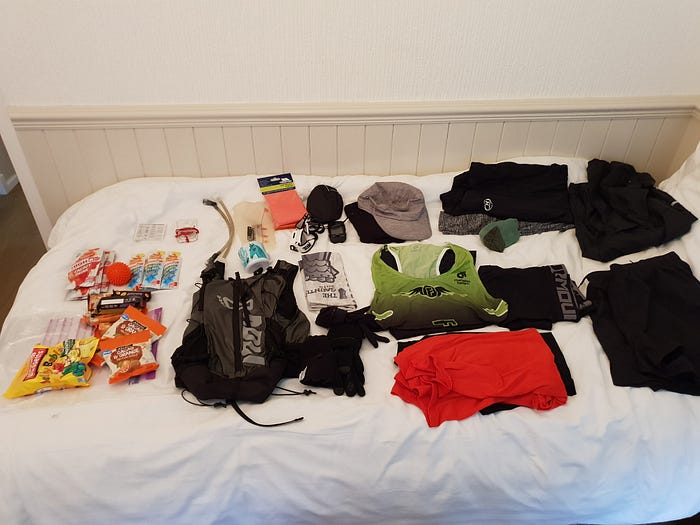
Race day
Race day started at 4.30am. Time to get fed, dressed and spend some time in the bathroom. The bus taking us to the start line left Cartmel not long after 5.45am. Took 90 minutes to get to Caldbeck. Bit of an anti-climax to turn up for a race and spend the next hour and a half on a bus. It should have been a good opportunity to visualise ascending and descending the mountains like a fell-running hero. Instead, I just sat there fretting and wishing I’d spent more time on the toilet.
The much-anticipated meteorological shitstorm didn’t turn up at the start of the race. It was more like steady drizzle at this stage — the type you don’t really notice once you get going. And get going we did, bang on 8am. The moment had finally arrived after 12 months of training and anticipation. It would have been easy to get carried away — but remember, I told myself, not too fast. I had no intention of smashing it up the first hill. That’s a debt you’ll repay with interest later.
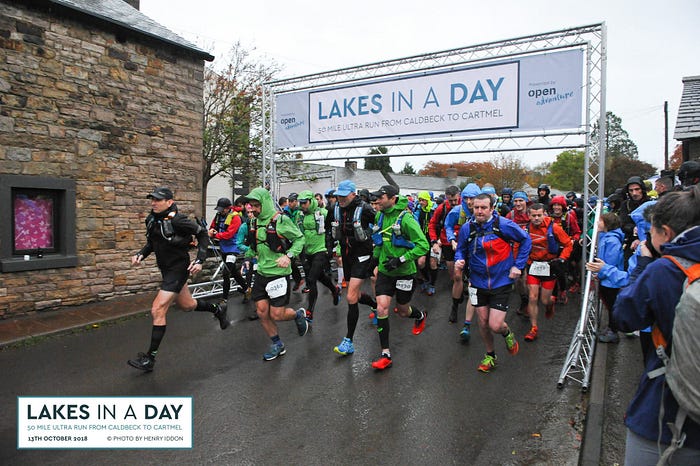
Caldbeck to Blencathra (13.5km, 02:11, 53rd overall, 53rd for section)
The first climb up to High Pike (658m, 5km in) was relatively leisurely. Chatting with Chris and a chap we’d done a couple of official race recces with earlier in the year. We were passed by a good number of people during the first few kilometres, and we’d started mid-pack. Important thing was not to panic and feel like you’re getting left behind. It’s an ultra-marathon, not, err, a marathon. We settled into a natural rhythm and reached the summit pretty much on schedule.
From High Pike we made our way down to Caldew river, where we’d cross before starting the climb up Blencathra (868m, 13.5km in). We had been warned that the water level had risen steeply and that race organisers had kindly installed a rope to help us get across. We took a good line down to the river and made up a few places. The water was high and fast flowing. Getting in you immediately felt the force of the current. One slip and you’d soon be heading down river at quite a pace. I hadn’t brought my goggles, so crossed cautiously.
The climb up Mungrisdale Common to Blencathra summit is famously miserable. There’s no distinct path, but rather a slog up boggy terrain. We’d recced it twice and were cursing both times. I decided to just get my head down and climb. I’d given myself an hour on this section and stuck to the task of maintaining the prescribed pace. What was waiting for us at the top of Blencathra was Halls Fell. A legendary ridge line leading down to Threlkeld, consisting of a rocky descent and not much wiggle room. I’d recced it three times, twice in the rain, so was prepared for the worst. I reached Blencathra summit and had a little breather, looked behind hoping to see Chris appear through the mist. I guessed he wasn’t too far behind, but I had a decision to make. We had talked about sticking together until Ambleside. Here I was at the top of Blencathra and we’d already split up. There’d been chat on the event Facebook page about mates doing it together, helping each other out through thick and thin. One voice told me to wait. Another told me to get going. I listened to the latter. I knew Chris would be okay.
Blencathra to Threlkeld CP (2.5km, 00:39, 47th overall, 51st for section)
I ended up descending Halls Fell well, 10 minutes faster than the recces. The specks of blood over the moist rocks kept me honest, though. At the bottom of the mountain was the first checkpoint (Threlkeld, 16km in). The village hall was a lot more relaxed than I was expecting. I had anticipated busy runners urgently grabbing some food and liquid before shooting off. But I found people sitting down, chilling out, taking their time. Fair enough. Was my strategy of getting in and out as quickly as possible a bit naïve? Some were handing in their numbers already — their race was done. I was surprised by this. The weather to Threlkeld had been mild. Yes, I was wet, but the rain had not been sideways, and the wind slow enough to pass by a school without breaking the speed limit. In hindsight, I think some were better at anticipating what was to come and decided to quit while they were ahead. Anyway, I grabbed a couple of pastries and got going.
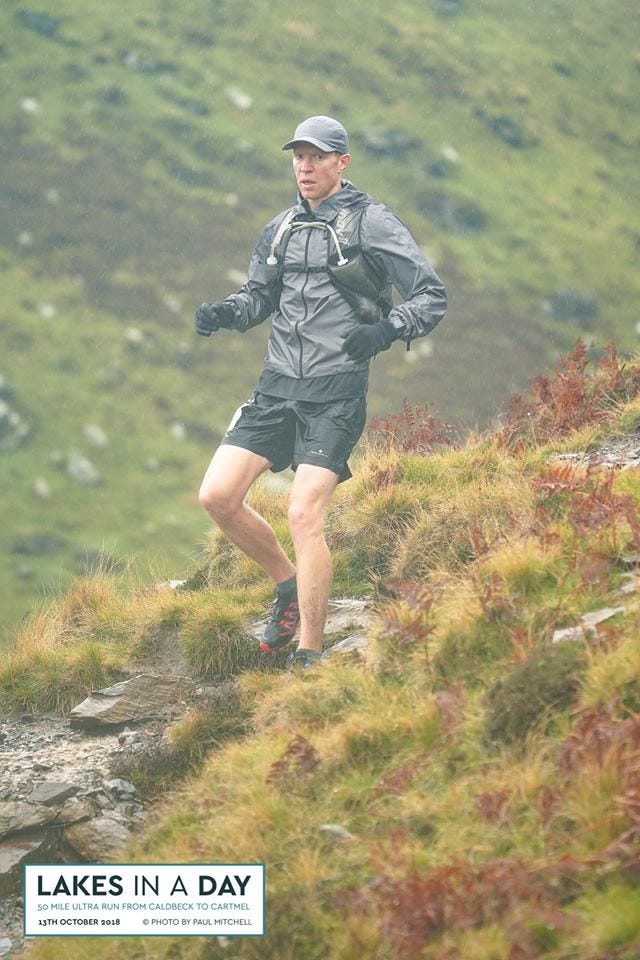
Threlkeld to Helvellyn, (15.5km, 02:25, 21st overall, 14th for section)
From the Threlkeld CP to the bottom of Clough Head was a few kilometres of easy running. I felt pretty good and caught up with a group of runners just as they were starting the ascent. One chap reckoned we were top 40. That’ll do me. My aim before the race, without really knowing what to expect, was top 50 and sub-14 hours. The little schedule I’d printed and laminated (NERRRRRD!) broke the route up into sections with a view to making it appear more manageable. Our climb up Clough Head followed the Bob Graham route. It was hard going, and I’d figured this might be the toughest part of the day. Boy was I wrong!
When we reached the summit (726m, 22.5km in) the weather changed dramatically. Slightly annoying rain turned to sideways sleet and where had this bloody wind come from? The weather in this next section was the worst I’d ever been out in. 70mph gusts coming at you head on. I was running with a very prominent lean just to stay upright. Still, I was moving better than others and made up a few more places. However, between Great Dodd (857m) and Helvellyn (950m) I felt myself getting colder. My base layer had become sodden and I was starting to shiver. I wanted to stop and change but felt this wasn’t an option. There was no shelter and trying to swap layers in these windy conditions could have meant lost clothing. I just carried on. My inexperience on the fells here was obvious. I was relying on my ability to move quickly, rather than an ability to handle the conditions well. How much longer would this last? I was relieved to see Helvellyn trig (950m, 31.5km in).
Helvellyn to Ambleside (14.5km, 02:56, 33rd overall, 78th for section)
Things didn’t get better, however. The passage from the top of Helvellyn down to Grisedale Tarn was the worst part of the race for me. I was getting colder, moving slowly, and felt my legs starting to suffer. This was Borrowdale repeated, just minus the sunshine. The waves coming off Grisedale Tarn were impressive. I had said to Chris previously that I wouldn’t mind a swim in there. Not today. I found enough shelter to take my jacket off and add another layer. I was soaking wet, but this would add some warmth. Arriving at the bottom of Fairfield was a relief as it meant I didn’t have to run. This would be the last big climb. I’d lost loads of places by now but was starting to think more in terms of just finishing the race regardless of position.
I had three runners above me in sight, and as I got closer it was clear that something wasn’t right. Two of them were helping the third up the mountain. On closer inspection I realised that the chap in trouble was the one we’d given a lift to the other night — he was struggling to put one leg in front of the other. At the time I didn’t stop to think whether taking him up the mountain was the right thing to do. I just put my shoulder to his arse and helped with the push. What were we going to do with him at the top of Fairfield? Was one of us prepared to sacrifice our day to get this chap to safety? Fortunately, we never had to answer this question. We met a group coming off Fairfield and they offered to take him down. Good lads, you got us out of a hole there. (I saw matey after the race and he said he was fine, and that he wished he had carried on. I told him that was never an option and that we should all be thankful to the descending group).
Arrived at the top of Fairfield (873m, 37km in) without further drama, and began the journey down to Ambleside. This section is easily underestimated, as the terrain over Hart Crag and Dove Crag is hard going and requires (from me anyway) more scrambling than running. I was struggling to find any kind of rhythm. One of the chaps with whom I’d climbed Clough Head came past and could see I was struggling. He shouted at me ‘Just get off this fucking mountain’. This became my mantra for the remaining miles into town. Just get off the mountain. Don’t think about what you’re going to do when you get there. Just get off the mountain. It was tough, but I was over the hump — literally and figuratively. I wasn’t moving particularly quickly, but the terrain started to improve. The last bit of drama was a fellow runner telling me I was going the wrong way. I disagreed and suggested we stick together. He chose a different path. Despite this seed of doubt being planted I was 95% sure of my direction. I was relieved to find something familiar from my recce and followed the path into town. Tarmac never felt so good! But I was sore, very sore.
Ambleside to Finsthwaite (22.5km, 03:17, 20th overall, 16th for section)
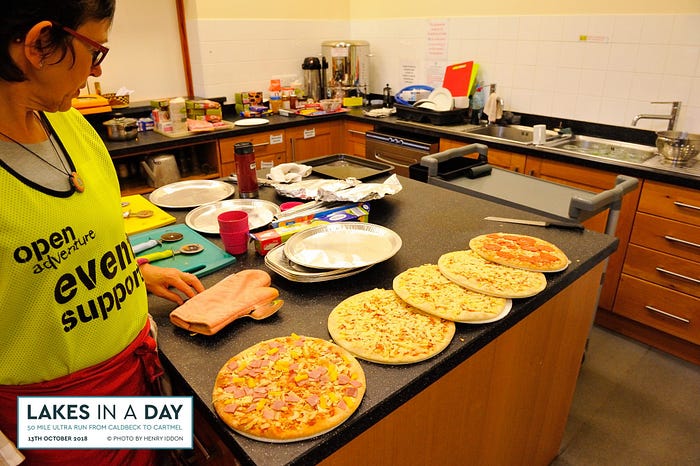
My plan had always been damage limitation in the first half of the race, and then hopefully be in a position to run the flats and downhills in the second half. I felt like I’d blown it, entering the Ambleside CP (46km in) with a mix of relief and frustration. Had I gone too hard? I’d tried to take things steady, but I was almost broken. Then something miraculous happened. I took my time, without sitting down and getting too comfortable. I changed into my remaining dry clothes and felt immediately better. 10 slices of pizza and half a litre of coke later, and it was time to get back out there.
I have difficulty explaining this transformation at Ambleside. Was it really as simple as a change of clothes and scoffing a medium-sized margarita? Or had I entered the CP feeling a bit too sorry for myself? Anyway, I left feeling brand new. The momentum was momentarily broken by a bit of flooding on the route out of town. The cars were struggling to pass and there were long queues. At one particular pinch point a policewoman was directing traffic. I asked her if it was okay to for me to pass — she smiled and nodded the way forward. It was a bit weird running (wading?)down the middle of the road past a load of stationary cars up to their wheel arches in water. Some encouraging words helped me on my way, and it wouldn’t be the last time I’d get wet that evening.
I was more in my element now. The rain was lighter, the wind had dropped, and I was moving relatively well. All that was left was a 35km trail run with a few ups and downs. Bread and butter. And it did feel good. I figured I’d left Ambleside just inside the top 40, and the prospect of picking off a few runners between now and Cartmel was enough motivation to keep a steady pace.
The second half of the race wasn’t entirely without its challenges, however. The route takes you along a path adjacent to Windermere. Except tonight we would be running through the lake, rather than alongside it. Not exaggerating to say that I was waist-high in water on more than one occasion. Tripped over a couple of times on some well-hidden roots, and nearly went nipples skywards on a couple of wet, wooden bridges. All part of the fun, but these obstacles would be even more lethal in the dark. I spared a thought to those runners who would be passing through here in the next few hours. Massive respect to anyone who completed this race, especially those who took the longest — demonstrating huge willpower to just keep going.

The head torch came out not long before the climb up to High Dam (67km in). I say climb, it felt more like a brisk walk considering what had come before. High Dam looks like a lovely spot, even in the dark. As I started the descent into Finsthwaite, decided I wasn’t going to stop at the final CP. From there it’s only 12k or so to the finish, and I had a bar of chocolate to get me through. It was one of the best decisions I made on the day, as I felt pretty good on the final section into Cartmel and didn’t need a break. Having a checkpoint strategy for these races is really important. It’s easy to waste time at CPs.
Finsthwaite to Cartmel (12.5km, 01:39, 19th overall, 7th for section)
Bit of a hairy moment running through the field out of Finsthwaite, though. I managed to upset a cow, who made a rather loud noise and appeared to make a move towards me. It helped me run a little quicker. Caught up with a runner a few minutes later who complained that a cow in the same field had tried to headbutt him! Sensitive beasts, those Finsthwaite cows.
Not much happened from there on in. Have to say that I was really impressed with the waymarking on the second half of the race. I vaguely knew where I was going, having recced the route, but the little yellow signs were a massive help. It was such a relief when the light from your headtorch caught the fluorescent arrow. The last tricky part of the race was running through the fields of Speel Bank (76km in) where you have to dodge sheep that look like boulders, and vice versa. Once you’re through there, its downhill all the way into Cartmel. My penultimate kilometre was the fastest of the day at a leisurely 4min 42secs. At the time it felt like I was going at the speed of an Olympic sprinter and that my quads would need to put out with a fire extinguisher.
Slowed down again to enjoy the adoration of the assembled hoards in Cartmel. In fact, I only saw one person as I ran through the village — my Dad. He was outside the Kings Arms in the rain shouting encouragement. I told him I’d be back soon. That first pint wouldn’t touch the sides.
I finished not long after 9pm. I was delighted with that. It was under my target time and good enough for 18th male, and 19th overall (congrats Katie Kaars Sijpesteijn on her win and new course record). I’d made up a fair bit of ground in the second half of the race and still wonder whether I’d be better suited to lumpy trail running than this mountain stuff. I won’t be giving up on the fells quite yet, though.
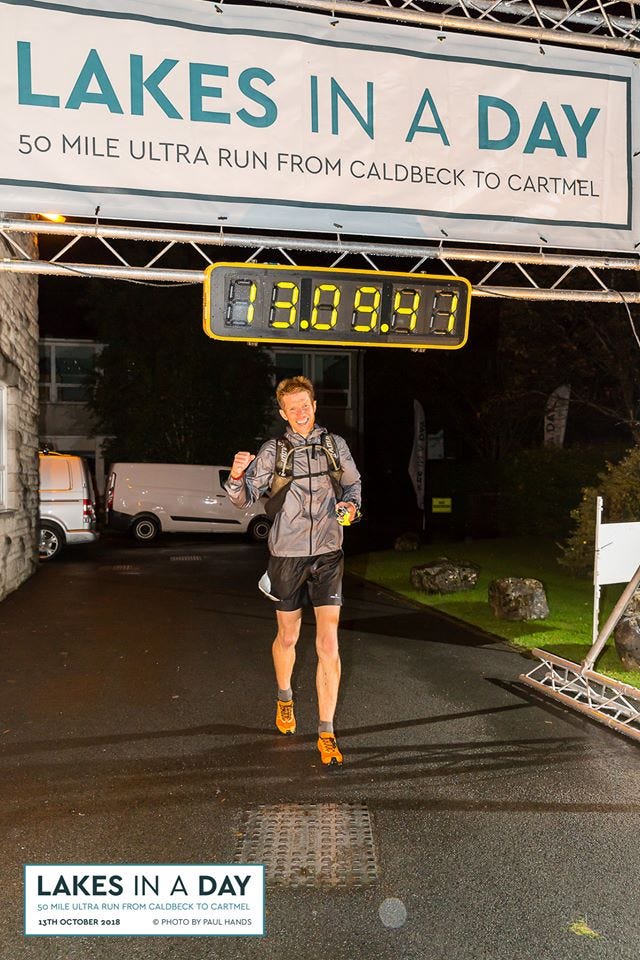
It was great to see a friendly face in Liz Aitken at the finish line and have a chat about the race. With her determination and endurance she’ll make a great Lakes in a Day competitor.
Liz told me that Chris was either still in Ambleside or his tracker had given up. I’d received a text from Chris when he reached Ambleside a couple of hours earlier, and there was no mention of any problems. I wasn’t worried in the slightest, he knows how to get through tough times. The man himself texted me a bit later, ETA of approximately 1am. Time for the best shower in the world and a couple of pints then! I was chuffed to see him cross the line bang on time. We’d both worked bloody hard to get this far. What a wet and wonderful day!

Post-race
I was overwhelmed by the number of messages from family, friends and Freedom members post-race. Ultimately, you do these events for your own sense of achievement. No one cares more than you. That said, I feel very lucky to be surrounded by people who are genuinely interested in how you get on. You know when you’ve done well, and it’s great to have that recognised by others. If you’ve managed to read this far, it shows that you care, so thank you.
Running is such a massive part of my life now. I bloody love it and embrace the challenge of getting better. It doesn’t matter where you are in your running journey, or where you finish in a race — as long as you enjoy working hard, you’ll make gains.
Bring on the next challenge!
